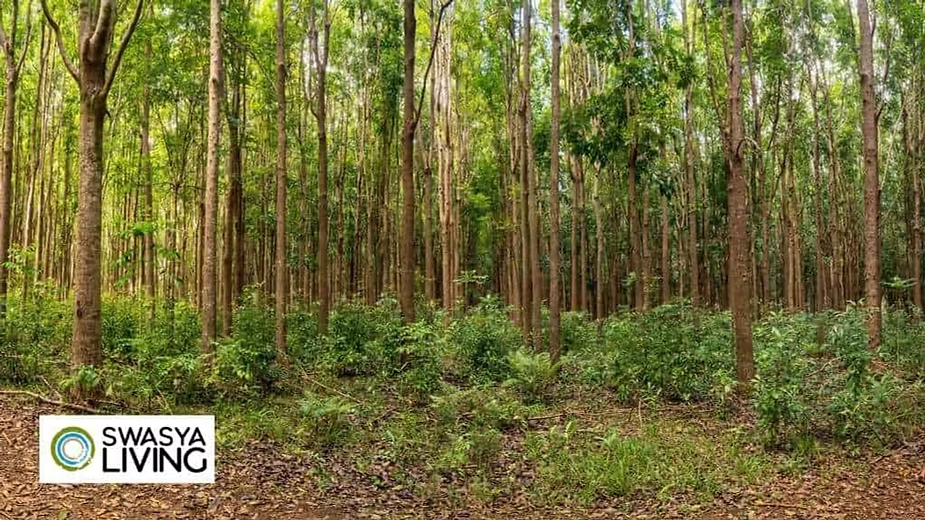Mahogany Tree Farming Uses and Benefits: A Sustainable and Lucrative Venture
Published on July 29, 2025

Mahogany, a tropical hardwood prized for its exceptional beauty and durability, has long been covered by furniture makers, boat builders, and woodworkers worldwide. However, due to overexploitation and deforestation, natural mahogany populations have dwindled, leading to a growing interest in mahogany tree farming. Whether you're interested in starting a mahogany tree plantation or learning about its uses, benefits and growth time, this guide will help you understand the essentials of mahogany tree farming in India.
Mahogany Tree Benefits
The mahogany tree offers a range of benefits, from timber production to medicinal applications. Its wood is primarily used for making furniture, flooring, and musical instruments. Beyond timber, the bark and leaves of the tree are believed to have medicinal properties.
1. Valuable Timber
Mahogany is one of the most valuable timber species globally, commanding premium prices in the market. Its distinctive reddish-brown hue, straight grain, and resistance to rot and insect attacks make it a highly sought-after wood for various applications.
2. Environmental Benefits
Mahogany plantations contribute to reforestation efforts, counteracting deforestation and promoting biodiversity. These trees help sequester carbon dioxide, purify the air, and provide habitats for numerous plant and animal species.
3. Economic Opportunities
Mahogany tree farming offers a long-term investment opportunity for landowners and communities. As the demand for sustainably sourced mahogany continues to rise, well-managed plantations can yield significant economic returns.
Starting a Mahogany Tree Plantation: Establishing a Sustainable Forest
Setting up a mahogany tree plantation requires careful planning, especially when it comes to mahogany tree planting distance. Typically, the recommended spacing between seedlings is 4x4 meters to allow adequate room for growth.
1. Site Selection
Choosing the right location is crucial for a successful mahogany plantation. Mahogany trees thrive in tropical and subtropical regions with well-drained soils, ample rainfall, and warm temperatures throughout the year.
2. Seedling Propagation
Mahogany seedlings can be obtained from reputable nurseries or grown from seeds. Proper seed treatment and nursery practices ensure healthy and vigorous seedlings for planting.
3. Plantation Design
Careful planning is essential for efficient management and harvesting. Factors such as spacing, row arrangements, and intercropping with complementary species should be considered.
4. Maintenance and Management
Regular weeding, pruning, and thinning operations are necessary to promote optimal growth and quality timber production. Sustainable forestry practices, such as selective harvesting and replanting, ensure the long-term viability of the plantation.
Mahogany Tree Uses: Versatility and Durability
Here are some primary uses of Mahogany Tree:
1. Furniture Making
Mahogany's unparalleled beauty and strength make it a prime choice for high-end furniture, cabinetry, and interior woodwork. Its rich colour and distinctive grain patterns add elegance and sophistication to any piece.
2. Boat Building
The durability and weather resistance of mahogany make it an ideal material for boat construction, particularly for decking, trim, and interior panelling.
3. Musical Instruments
Mahogany's tonal qualities and workability make it a favoured choice for crafting musical instruments, such as guitars, pianos, and drums.
4. Flooring and Panelling
Mahogany's natural luster and resistance to wear and tear make it a popular choice for high-end flooring and panelling in homes and commercial spaces.
5. Outdoor Furniture and Decking
Mahogany's resistance to rot, insects, and weathering makes it an excellent choice for outdoor furniture, decking, and other exterior applications.
Mahogany Tree Growth Time and Yield
The mahogany tree growth time varies depending on soil and climate conditions. On average, the tree can take between 12 to 15 years to fully mature. However, with proper care, it can start yielding good quality timber in as little as 8 years.
Factors affecting mahogany tree growth time:
- Soil quality
- Sunlight and water availability
- Regular pruning and maintenance
Mahogany Tree Farming in India: A Sustainable Solution
As the world becomes increasingly conscious of the need for sustainable practices, mahogany tree farming emerges as a viable solution to meet the demand for this precious wood while preserving natural forests. By cultivating mahogany plantations responsibly, landowners and communities can contribute to environmental conservation while generating long-term economic benefits.
One notable example of well-managed farmland is Swasya Living’s Sannidhi Eco Farms, located in Sakleshpur, India. This farm has set a benchmark for sustainable cultivation, employing best practices in plantation management, responsible harvesting, and community engagement. Offering the best amenities, eco-friendly environment, community-living experience, and guaranteed ROI per annum, you must visit the farm right away!
To Conclude
Farming mahogany trees can be a sustainable and profitable business in India. By understanding the correct planting methods, mahogany tree benefits, and the ideal mahogany tree growth time, you can set up a successful plantation that provides high returns.
